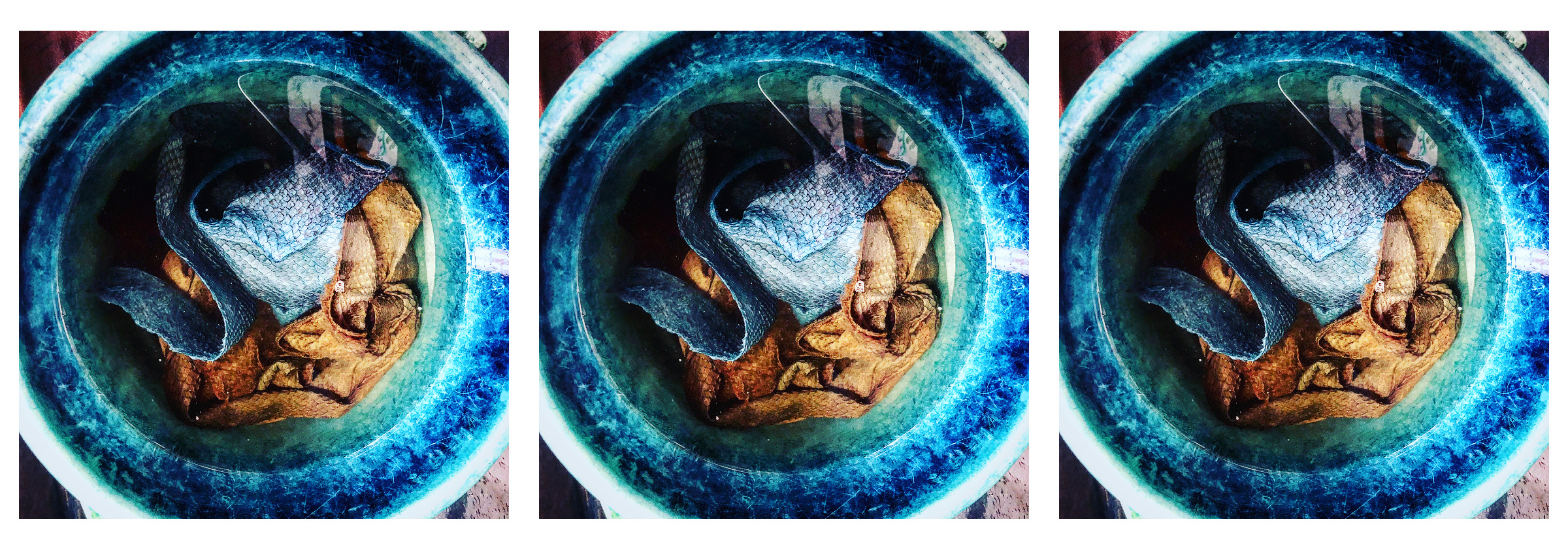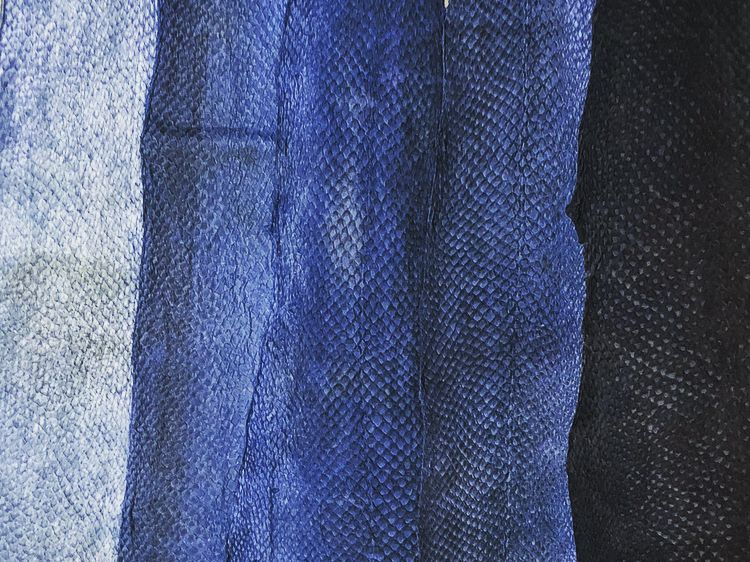Elisa Palomino is the Senior Lecturer for BA (Hons) Fashion: Fashion Print at Central Saint Martins (CSM), as well as being a CSM alumna. Her interest in integrating traditional craftmanship methods with new technologies, as well creating sustainable textiles has led her to research and developing the use of fish leather, and it’s potential use as a new alternative raw material for the fashion industry.
Here we chat to her about her time at CSM as a student and as an educator, and her research into fish skin leather, and its potentials within the fashion industry.

What is your background?
I grew up in Cuenca, a Spanish XV century town surrounded by art and nature. My training was working in the luxury fashion industry for over 25 years, at brands such as John Galliano and Christian Dior, Roberto Cavalli, Moschino and Diane von Furstenberg. In 2010 I launched my own label showing at New York, Milan, Rome, Madrid and London fashion weeks.
I have a history of working across educational institutions including international museums and galleries. I have a teaching portfolio in a number of locations around the world such Parsons, FIT, San Francisco Academy of Art, Polimoda, The Royal Danish Academy of Fine Arts, Iceland University of the Arts, Shenkar University, Bunka Gakuen and IED. I have sat on a range of international committees including International Talent Support (ITS), Mango International Fashion Competition, and Bilbao Arts and Fashion.
What are your inspirations?
My work aims at integrating traditional craftsmanship methods with new technologies, keeping in mind the importance of the environmental, ethical, and social impact of fashion materials. My research aims to activate new models for sustainable textiles encouraging artisans to continue to produce craft and to pass their skills onto others, particularly within their own communities.

As an alumna of CSM, what was your time at the College like? What was the best thing about CSM?
During my MA in Fashion Design, I specialised in printed textiles using traditional screen-printing, and fabric manipulation with a strong emphasis on material exploration. Graduating in 1992, I had the chance to experience one of the most creative eras of St Martins, having as friends and classmates Lee McQueen, Hussein Chalayan, Matthew Williamson, Antonio Berardi, Giles Deacon, and Clements Ribeiro to name a few.
Has CSM changed since your time studying there and now teaching there?
My current practice as an educator in the Fashion Print Pathway at CSM aims at supporting students in engaging with sustainability. Since my appointment at CSM, I have pioneered the adoption of sustainable practices into the Fashion Print education curriculum, developing best practice between craft and digital design. I urge students to rethink their work, to reflect on overconsumption and waste, to commit to reverse the damage done by the fashion industry by being mindful, and to recuperate, repair, reuse, recycle and upcycle, using a combination of traditional craftsmanship and low technology to produce their collections. I have provided craftsmanship and artisanal training programs to promote students using handwork techniques to safeguard the rich heritage of the luxury industry. Print technicians keep adapting their workshops to teach safer and more effective practices and extra sustainable Print & Dye techniques.

Why did you choose to focus on fish leather?
The project emerged from a personal design interest in the potential use of fish skin leather as a new alternative raw material for the fashion industry. I am currently a PhD fellow at London College of Fashion (LCF), Centre for Sustainable Fashion. My doctoral research explores Fish Skin, sustainability and craftsmanship and is an interdisciplinary collaboration to study northern indigenous fish skin heritage, building connections between anthropology, ethnography and environmental protections to address current global issues of fashion sustainability.
When and how did you establish FISHSKINLAB?
I established FISHSKINLAB three years ago as a testimony of my PhD research.
FISHSKILAB recent projects:
- Fulbright Scholar Award to study ‘Arctic Fish Skin clothing traditions around the circumpolar region’ at the Arctic Studies Center, Smithsonian Institution in Washington and Anchorage
- EU Horizon 2020-MSCA-RISE-2018. Research and Innovation Staff Exchange. Marie Sklodowska Curie. Fish Skin: Developing Fish Skin as a Sustainable Raw Material for the Fashion Industry.
- Worth Partnership Project. Funded by EU, EASME, under (COSME 2014-2020). Access to financial funding and mentoring to create a fish skin leather clutch collection with Atlantic Leather
- Daiwa Foundation Grant. Japanese dyes on fish skin leather as a greener alternative to exotic leathers.
- Nordic Culture Fund. OPSTART. Grant to deliver the Nordic Fish Leather craft workshop at Atlantic Leather.
- FRPAC. Foundation for Research and Promotion of Ainu Culture. Grant to deliver a workshop on Ainu Fish leather craftsmanship at the Nibutani Ainu culture museum, Hokkaido, Japan
- Hezhe Fish skin craft platform. Platform co-created with the Hezhe Research Society of Tongjiang City, Intangible Cultural Heritage Protection Center.

What is the process of making fish leather usable as a material?
Making leather from fish skin is an ancient craft historically used by many Arctic coastal cultures. Fashion has recently assimilated the use of fish skin by aboriginal people as an innovative sustainable material due to their low environmental impact. Fish skins are sourced from the food industry, using waste, applying the principle of a circular economy. They require no extra land, water, fertilisers or pesticides to produce them. Fish leather offers outstanding longevity and is highly biodegradable.
By using fish leather I aim to preserve and disseminate the cultural heritage connected with fish skin linking the preservation of traditional knowledge taking into consideration the sustainable limits of the planet's natural resources. Through my work, I have researched skin processing technology based on traditional knowledge from Arctic indigenous communities including mechanical tanning and the use of environmental substances such bark, brain, urine, oil and cornflour for tanning. By being inspired by the fish skin tanning methods of aboriginal people around the world, we could be able to promote them to a wider audience.
I read that you used fish leather back in 2002 for John Galliano and Christian Dior; have you always been interested in using alternative and sustainable practices and materials in your work?
My fish skin research draws on the design practice that was instigated whilst working as head of the design studio at John Galliano, developing fish leather garments for John Galliano and Christian Dior collections in 2002. We were amongst the first brands to use fish leather and by doing so, we situated the barely unknown sustainable material within the context of the luxury Industry.

You’ve also mentored a number of designers who have gone on to do incredible things, such as Richard Quinn. How do the mentor/mentee relationships come about, and how important do you think mentoring is?
As per Richard own words:
"Elisa continues to be an inspiration in my work and ways of working. A passionate, creative mentor and teacher. I was continually inspired with the depth of knowledge and dialogue we shared together. A unique approach to fashion and textiles that will encourage you to produce the best version of your work. Elisa has worked in the highest of positions of Dior Couture at the most exciting moments of fashion history. The depth of technical and creative knowledge Elisa has for me was unrivalled and she was so generous with her knowledge to make me grow as a designer and a person. My career has been shaped by my formative years at Central Saint Martins with the guidance of Elisa and her passion and creativity. Elisa is like no other teacher I have ever had."


